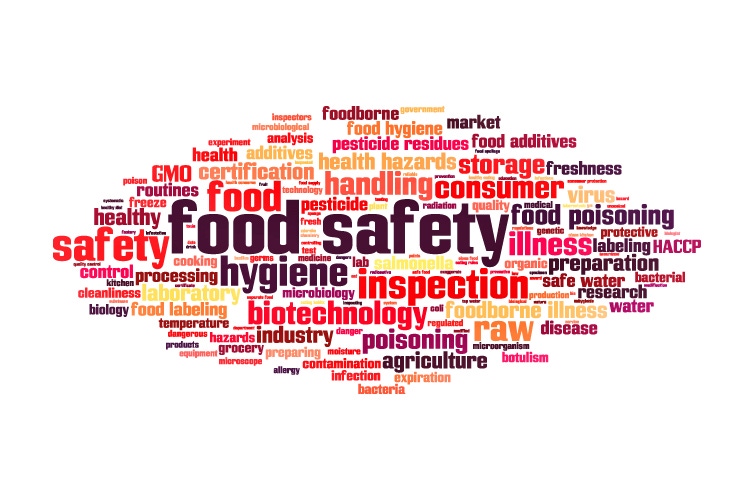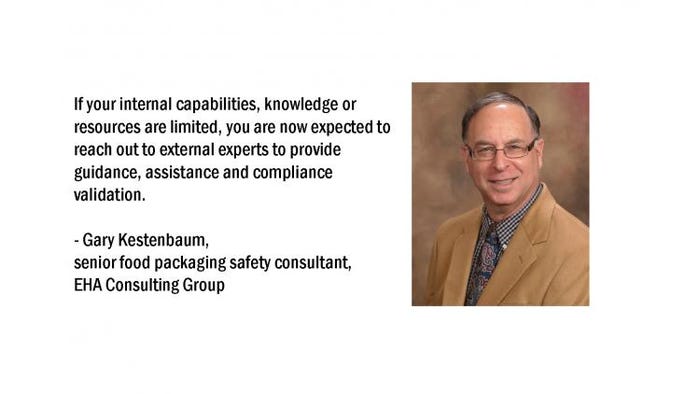FSMA update: Is your organization informed and aware?
October 20, 2016

Food safety expert Gary Kestenbaum provides updated suggestions for packaging industry quality and safety managers regarding FSMA rules.
Welcome to autumn, readers! Now that vacations are over and we are between critical seasons, it’s a great time to (re)focus on the latest updates to and requirements of the Food Modernization Safety Act, namely the requirements connected to the final rules and the direction of impending rules described by drafts and models.
Final Rules
Subject-specific final rules have been issued under FSMA and published by FDA relating to:
Establishment and Maintenance of Records
cGMPs and HARPC for Animal Food
cGMPs and HARPC for Human Food
Food Supplier Verification Programs for Imports
Produce
3rd Party Auditing
Safe Transportation of Food
Intentional Adulteration Protection (Food Defense “Plus”)
Facility Registration (amendments)
Compliance Dates (clarification and extensions)
Drafts, models and guidance documents
FDA reaches out ongoing to industry, and encourages input and feedback from a broad range of food supply participants and members prior to the finalization of FSMA rules. The FDA website contains links to a collection of model and draft rules and standards as well as guidance documents and rule “at a glance” summaries.
Interpretations and definitions
There are too many packaging industry - related details and mitigating variations to address or cover in this update. Suffice it to say, the internet is replete with many valuable technical, legal and functional white papers containing guidance and interpretations relating to food, food packaging and related industry supply chain participants including, but not limited to the frequently asked questions
“What are the differences between the two mainstream, recognized hazard control programs HACCP and HARPC?”
and
“What is the definition of a ‘Qualified Person’ in regards to establishing and overseeing a Food Safety Preventive Controls program”?
Answers to excellent questions such as those can be found on the web.
Reacting to objectives and intent
Recently, Ms. Joann Givens, co-chair of the FSMA Operations Team Steering Committee and director of FDA’s Food and Feed Program in the Office of Regulatory Affairs, provided answers in a straightforward FSMA Q & A which can be found on FDA’s website.
Her answers contain general FDA perspectives, expectations and guidance for the greater food industry. She advises that food facilities should, by now, be taking measures required by the intent of each rule to transform their food safety systems. Facility food safety SMEs should oversee assessments of products and processes for vulnerabilities which might compromise the integrity of food or food contact packaging safety, and respond with preventive adjustments designed to control risks. Prompt responses to risks, in advance of their becoming violations, can prevent them from impacting the safety of the food supply chain.
She also stressed the need for each facility to set up a thorough system of documentation. Execution of recordkeeping best practices acts as evidence that the FSMA legal standard is being met.
In general, she advises affected supply chain managers to put processes and procedures in place to prevent problems before they occur and consider building in system redundancy as backup. She advised that in the event of a food safety compromise, state or federal investigators will ask the questions “when problems came to your attention, what did you do? Were you proactive in looking for problems in the first place? If you could not find a solution, did you get the right expertise? Did you educate your employees”?

Ultimate regulatory goal
The FDA site Q&A explains that FSMA rules require each affected food facility to create a validated, effective self-sustaining preventive, food safety system with operations that are FSMA compliant.
FSMA preventive controls requirements were written to shift the culture of food safety from reaction and correction to pre-incident analysis and prevention.
Chairperson Givens’ final comment may be her most insightful. She advises “We want to see people doing the best they can. It’s a marathon, not a sprint. They’re learning; we’re learning. We are very committed to educating while we regulate to align understanding and expectations”.
Advice
Regardless of whether you provide equipment, food contact packaging or related goods and services, you or a customer in your chain of supply will ultimately need to comply with one or more of the FSMA rules. Work against the assumption that even if your business and facility are exempted from complying with FSMA, eventually, a partner will be affected.
If your internal capabilities, knowledge or resources are limited, you are now expected to reach out to external experts to provide guidance, assistance and compliance validation. Ignorance and mistaken interpretations are not valid excuses for non-compliance.
As your organization adjusts programs, policies, procedures and operations to align with FSMA objectives of risk identification and prevention, so then will you assist your partners in their quest to achieve compliance and protect consumers!
Gary Kestenbaum has 40 years’ experience in the food and packaging industries, 6 as a supplier with National Starch, 18 as a product developer with General/Kraft Foods and 15 as a packaging engineer and developer with Kraft. As senior food packaging safety consultant with EHA Consulting Group, Kestenbaum provides guidance on packaging safety and suitability-related projects for raw material manufacturers, converters and associated supporting professionals. He can be reached at [email protected] or 410-484-9133. The website is www.ehagroup.com.
___________________________________________________________________________________
Want to explore fresh ideas in materials and machinery for food packaging? Visit PackEx Montréal, November 30, 2016 to December 1, 2016.
___________________________________________________________________________________
About the Author(s)
You May Also Like




